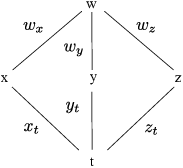Suppose ![]() and
and ![]() are functions of several variables, where
the number of outputs of f equals the number of inputs of g. You can
"chain" f and g together to make the composite function
are functions of several variables, where
the number of outputs of f equals the number of inputs of g. You can
"chain" f and g together to make the composite function
![]() :
:
![]()
That is, ![]() .
.
The derivative of ![]() is given by the
Chain Rule. It is exactly what you'd expect, based on your
experience with functions of one variable.
is given by the
Chain Rule. It is exactly what you'd expect, based on your
experience with functions of one variable.
Theorem. Suppose ![]() is
differentiable at c, and
is
differentiable at c, and ![]() is differentiable at
is differentiable at
![]() . Then
. Then ![]() is differentiable at c, and
is differentiable at c, and
![]()
In fact, ![]() can be represented by an
can be represented by an ![]() matrix, while
matrix, while
![]() can be represented by an
can be represented by an ![]() matrix. The
product on the right is the product of two matrices; it makes sense,
because the n columns of
matrix. The
product on the right is the product of two matrices; it makes sense,
because the n columns of ![]() are compatible with the n rows of
are compatible with the n rows of
![]() .
.
Example. Suppose
![]()
(a) Use the Chain Rule to compute ![]() .
.
(b) Find ![]() and
and ![]() .
.
(a) Here is a picture which shows the dependencies of the variables:

For example, changing s causes x, y, and z to change, which in turn causes u and v to change.
First, compute ![]() and
and ![]() :
:
![$$Df = \left[\matrix{ 2 s & -2 t \cr 2 s & 2 t \cr t & s \cr}\right], \quad Dg = \left[\matrix{ 2 y & 2 x - 3 z & -3 y \cr z & 0 & x \cr}\right].$$](chain-rule25.png)
Next, multiply to obtain ![]() , being careful to put
, being careful to put
![]() on the left:
on the left:
![$$D(g \circ f)(s, t) = \left[\matrix{ 2 y & 2 x - 3 z & -3 y \cr z & 0 & x \cr}\right] \left[\matrix{ 2 s & -2 t \cr 2 s & 2 t \cr t & s \cr}\right] = \left[\matrix{ 4 y s + 4 x s - 6 z s - 3 y t & -4 y t + 4 x t - 6 z t - 3 y s \cr 2 s z + x t & -2 z t + x s \cr}\right].$$](chain-rule28.png)
If you wish, you can substitute
![]()
This gives
![]()
Note: This kind of substitution becomes messy when the functions are at all complicated, so I'll often leave the derivative as a product of matrices with "different variables",
(b) Here is how to interpret the matrix for ![]() . The composite function is
. The composite function is ![]() . Therefore,
. Therefore,
![$$D(g \circ f)(s, t) = \left[\matrix{ \pder u s & \pder u t \cr \pder v s & \pder v t \cr}\right].$$](chain-rule33.png)
So, for example,
![]()
I'll check this directly.
![]()
Alternatively, if all you need is one of the partials (say ![]() ), you can use the variable dependency picture to get
the formula. Consider all paths in the picture from u to s. Label
each path with the corresponding partial derivative. For example, the
path from u to y is labelled with
), you can use the variable dependency picture to get
the formula. Consider all paths in the picture from u to s. Label
each path with the corresponding partial derivative. For example, the
path from u to y is labelled with ![]() .
.

Now to get ![]() , multiply along each path and add the
results:
, multiply along each path and add the
results:
![]()
Example. Suppose that ![]() ,
, ![]() ,
, ![]() , and
, and
![$$\eqalign{ Df(0, 1) = \left[\matrix{ 1 & -1 \cr 0 & 2 \cr}\right], \quad & Df(2, -2) = \left[\matrix{ 3 & -3 \cr 2 & 0 \cr}\right],\cr Dg(0, 1) = \left[\matrix{ 2 & 1 \cr 1 & 2 \cr}\right], \quad & Dg(2, -2) = \left[\matrix{ 1 & 1 \cr 5 & -1 \cr}\right]. \cr}$$](chain-rule44.png)
Find ![]() and
and ![]() .
.
First,
![]()
Now
![$$D(g \circ f)(s, t) = \left[\matrix{ \pder u s & \pder u t \cr \pder v s & \pder v t \cr}\right].$$](chain-rule48.png)
It follows that ![]() .
.![]()
Example. Suppose
![]()
![]()
Find ![]() .
.

![]()
Note: I'm leaving the answer in terms of x, y, z, and t. If you really needed everything in terms of t, you could substitute using the x, y, and z-equations.
Example. Suppose ![]() and
and
![]() are defined by
are defined by
![]()
![]()
Find ![]() and
and ![]() .
.

![]()
![]()
Note: I'm leaving the answer in terms of x, y, z, s, and t. If you really needed everything in terms of s and t, you could substitute using the x, y, and z-equations.
Copyright 2018 by Bruce Ikenaga